Picking from the multitude of sector mutual funds is a daunting task. In any given sector there may be as many as 213 different mutual funds, and there are at least 607 mutual funds across all sectors.
Why are there so many mutual funds? The answer is: because mutual fund providers are making lots of money selling them. The number of mutual funds has little to do with serving investors’ best interests. Below are three red flags investors can use to avoid the worst mutual funds:
- Inadequate liquidity
- High fees
- Poor quality holdings
I address these red flags in order of difficulty. Advice on How to Find the Best Sector Mutual fundsis here. Details on the Best & Worst Mutual funds in each sector are here.
How To Avoid Mutual Funds with Inadequate Liquidity
This is the easiest issue to avoid, and my advice is simple. Avoid all mutual funds with less than $100 million in assets. Low asset levels tend to mean lower volume in the mutual fund and large bid-ask spreads.
How To Avoid High Fees
Mutual funds should be cheap, but not all of them are. The first step here is to know what is cheap and expensive.
To ensure you are paying at or below average fees, invest only in mutual funds with total annual costs (TAC) below 2.40%, which is the average TAC of the 607 US equity mutual funds I cover. Weighting the TACs by assets under management, the average TAC is lower at 1.48%. A lower weighted average is a good sign that investors are putting money in the cheaper mutual funds.
Figure 1 shows the most and least expensive sector mutual funds in the US equity universe based on total annual costs. Saratoga Advantage Trust provides 3 of the most expensive mutual funds while Vanguard mutual funds are among the cheapest.
Figure 1: 5 Least and Most-Expensive Sector Mutual funds
 Sources: New Constructs, LLC and company filings
Sources: New Constructs, LLC and company filings
Saratoga Advantage Trust: Financial Services Portfolio (SFPAX) and Rydex Series Funds: Electronics Fund (RYELX) are two of the most expensive U.S. equity mutual funds I cover, while Vanguard Specialized Fund: Vanguard REIT Index Fund (VGSNX) and Vanguard World Funds: Vanguard Health Care Index Fund (VHCIX) are the least expensive. The more expensive SFPAX and RYELX receive my 1-star or Very Dangerous rating, while the cheapest mutual funds, VGSNX and VHICX receive my 2-Star and 3-Star rating, respectively. None of the most expensive mutual funds earn a better rating than the cheapest mutual funds. In other cases, quality holdings can make up for high costs.
However, investors need not pay high fees for good holdings. Vanguard World Funds: Vanguard Consumer Staples Index Fund (VCSAX) is my highest rated sector mutual fund and earns my Attractive rating. It also has low total annual costs of only 0.18%.
On the other hand, the Vanguard World Funds: Vanguard Industrials Index Fund (VINAX) makes up the fourth cheapest fund in figure 1. Despite the low costs, it earns a 2-star or Dangerous rating. No matter how cheap of fund, it needs to hold good stocks to deliver good returns.
This result highlights why investors should not choose mutual funds based only on price. The quality of holdings matters more than price.
How To Avoid Mutual Funds with the Worst Holdings
This step is by far the hardest, but it is also the most important because a mutual fund’s performance is determined more by its holdings than its costs. Figure 2 shows the mutual funds within each sector with the worst holdings or portfolio management ratings. The sectors are listed in descending order by overall rating as detailed in my 2Q Sector Rankings report.
Figure 2: Sector Mutual Funds with the Worst Holdings
 Sources: New Constructs, LLC and company filings
Sources: New Constructs, LLC and company filings
My overall ratings on mutual funds are based primarily on my stock ratings of their holdings. My firm covers over 3000 stocks and is known for the due diligence done on each stock we cover.
Fidelity appears more often than any other providers in Figure 2, which means that they offer the most mutual funds with the worst holdings. Fidelity Select Portfolios: Construction and Housing Portfolio (FSHOX) has the worst holdings of all Consumer Staples mutual funds. FSLEX, FBTCX, and FSUTX also all have the worst holdings in their respective sectors.
Note that no mutual funds with a Dangerous portfolio management rating earn an overall rating better than two stars. These scores are consistent with my belief that the quality of a mutual fund is more about its holdings than its costs. If the mutual fund’s holdings are dangerous, then the overall rating cannot be better than dangerous because one cannot expect the performance of the mutual fund to be any better than the performance of its holdings.
Figure 2 reveals that one of the cheapest mutual funds, Vanguard World Funds: Vanguard Consumer Discretionary Index Fund (VCDAX) gets my Dangerous rating because its holdings get my Dangerous rating. Similarly, Fidelity Select Portfolios: Construction and Housing Portfolio (FSHOX) also one of the cheapest mutual funds in Figure 2, gets a Dangerous portfolio management rating and, therefore, cannot earn anything better than a 2-star or Dangerous overall rating. Again, the mutual fund’s overall rating cannot be any better than the rating of its holdings.
Find the mutual funds with the worst overall ratings on my Mutual Fund screener. More analysis of the Best Sector Mutual funds is here.
The Danger Within
Buying a mutual fund without analyzing its holdings is like buying a stock without analyzing its business and finances. As Barron’s says, investors should know the Danger Within. Put another way, research on mutual fund holdings is necessary due diligence because a mutual fund’s performance is only as good as its holdings’ performance.
PERFORMANCE OF MUTUAL FUND’s HOLDINGs = PERFORMANCE OF MUTUAL FUND
Best & Worst Stocks In these Mutual Funds
Applied Materials, Inc. (AMAT) is one of my least favorite stocks held by RYELX and mutual funds and earns my Very Dangerous rating. Over the past nine years, AMAT’s after-tax profit (NOPAT) has declined by 8% compounded annually. The company’s return on invested capital (ROIC) is also much lower than it used to be, currently at 6%, down from 23% just two years ago. The market seems to think a turnaround is coming for AMAT though, as the stock is up nearly 50% in the past year. To justify its current price of ~$19/share, AMAT would need to grow NOPAT by 12% compounded annually for the next 20 years. Even if AMAT executes on its turnaround, it’s hard to see much upside at this valuation.
Equity Residential (EQR) is one of my favorite stocks held by VGSNX and receives my Attractive rating. Over the past nine years, EQR has grown NOPAT by 13% compounded annually. The company currently earns a ROIC of 11%, more than double the average of the 150 REIT companies I cover. The best part about EQR however is its valuation. At its current price of ~$59/share, EQR has a price to economic book value (PEBV) ratio of 0.9. This ratio implies the market expects EQR’s NOPAT to permanently decline by 10%. EQR’s track record of profit growth suggests it should be able to surpass these low expectations.
Kyle Guske II contributed to this article
Disclosure: David Trainer and Kyle Guske II receive no compensation to write about any specific stock, sector, or theme.
